Our Pillows
2017For One, In A Shared Room is an exhibition of works on paper, sculpture, video, and installation visualizing the site and form of intimacy. The works collectively describe intimacy in context to the ordinary and how memory, feeling, and people become intimately embedded in the objects and spaces of home.
Our Pillows is a group of large etchings originating from a practice of documenting mine and my partner's pillows every morning after waking up. The site of these pillows become after-images of the night before, suspended in a dream-like space made from the pressed texture of bed sheets etched into metal. The objects occupying our domestic spaces become stand-ins for us, reflecting back facets of our identity and mediating shared forms of emotional connection. The qualities of pillows reflect ideas of softness, rest, and comfort. In homage to Felix González-Torres’ work, these images function as portraits signifying the tenderness within queer life.

Installation view, 2017, Haw Contemporary, Kansas City, MO (photo by Brian Hawkins)

Our Pillows (at 2:33 PM), 2017, Etching with soft ground, aquatint, and drypoint on paper, 26" x 32" (photo by Brian Hawkins)
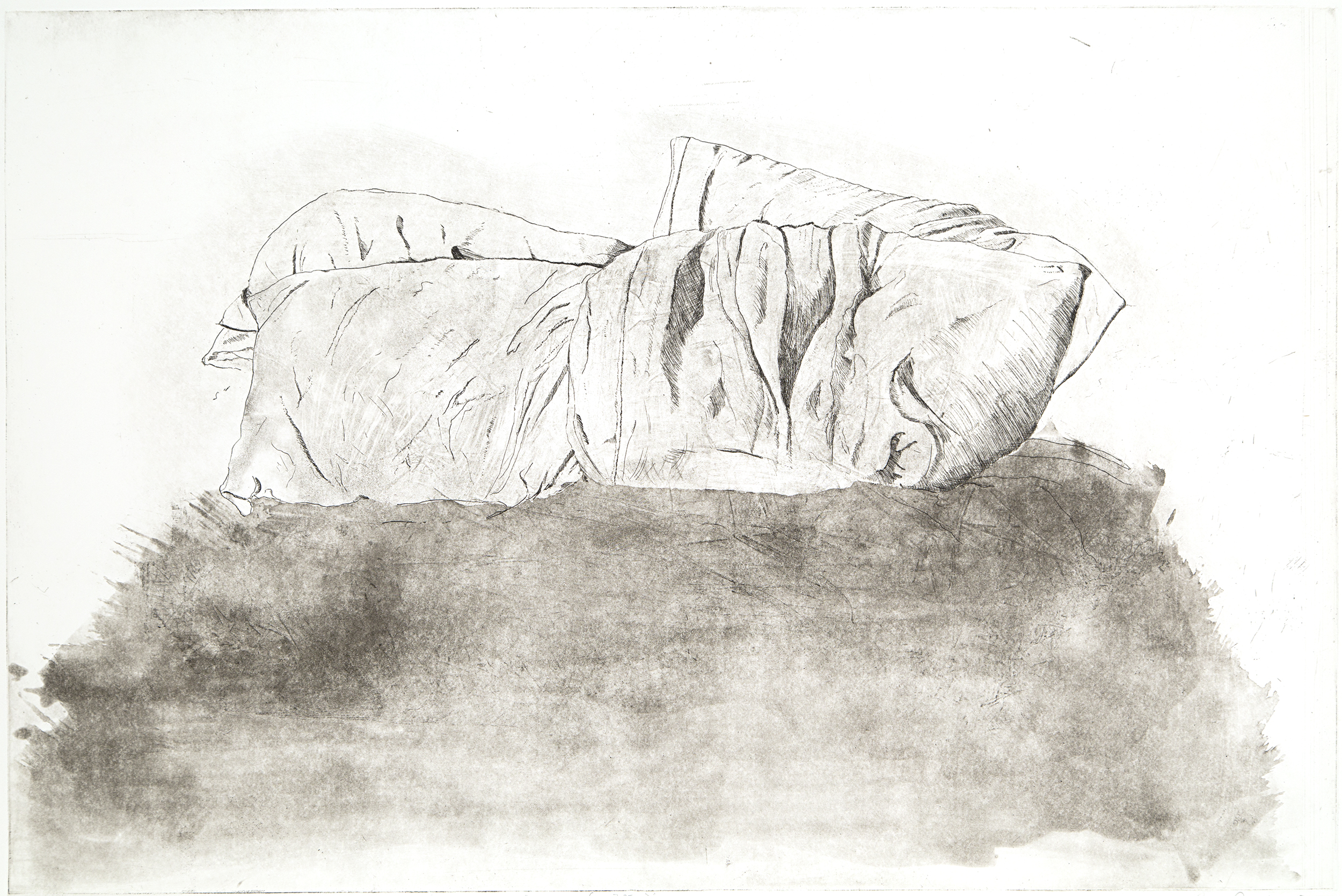
Our Pillows (at 7:35 AM), 2017, Etching with soft ground, aquatint, and drypoint on paper, 28" x 38" (photo by Brian Hawkins)
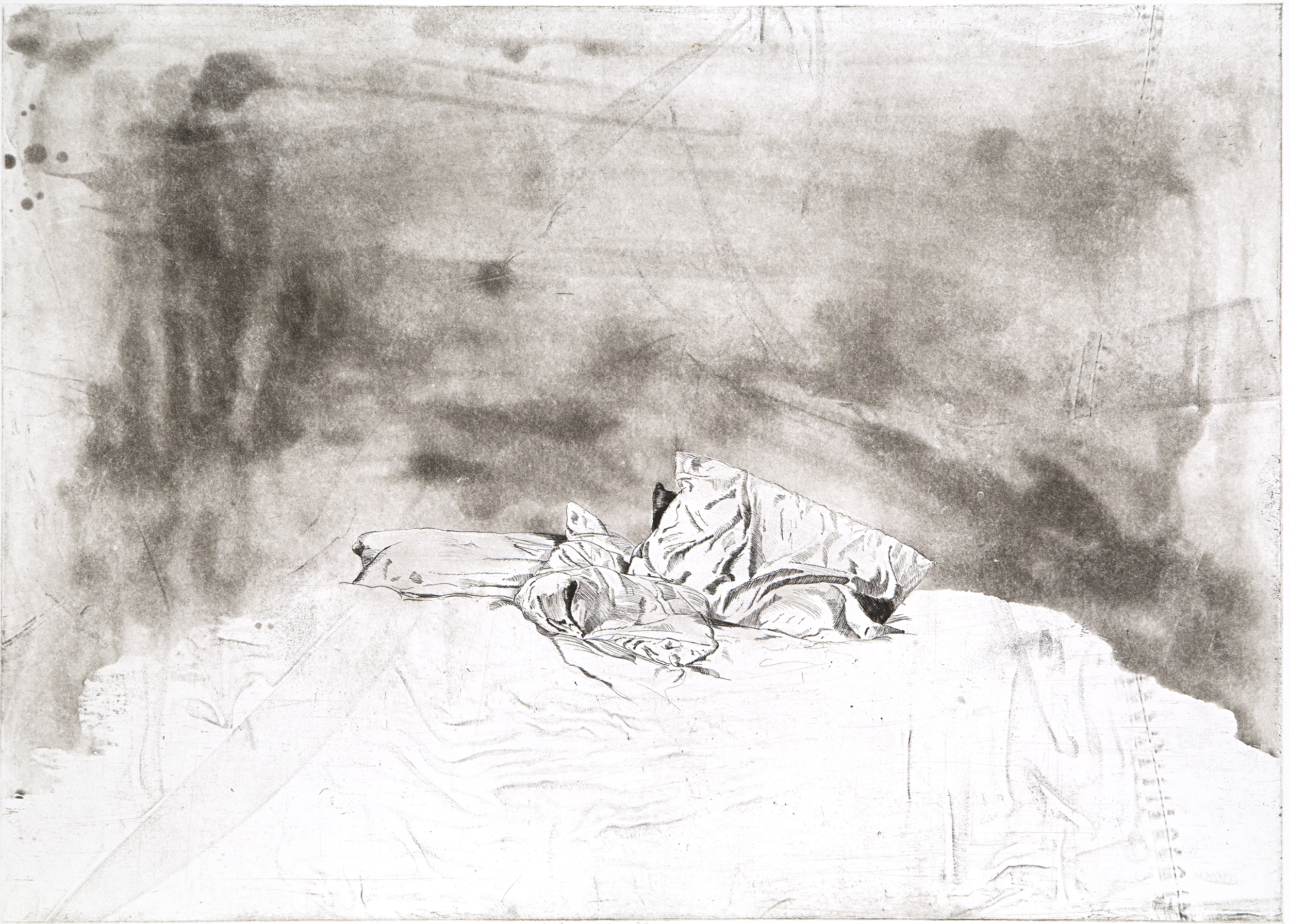
Our Pillows (at 10:34 AM), 2017, Etching with soft ground, aquatint, and drypoint on paper, 22" x 32" (photo by Brian Hawkins)
Pillow Talk
2017For One, In A Shared Room is an exhibition of works on paper, sculpture, video, and installation visualizing the site and form of intimacy. The works collectively describe intimacy in context to the ordinary and how memory and feeling become embedded in the objects and spaces of home.

Installation view, 2017, Haw Contemporary, Kansas City, MO (photo by Brian Hawkins)
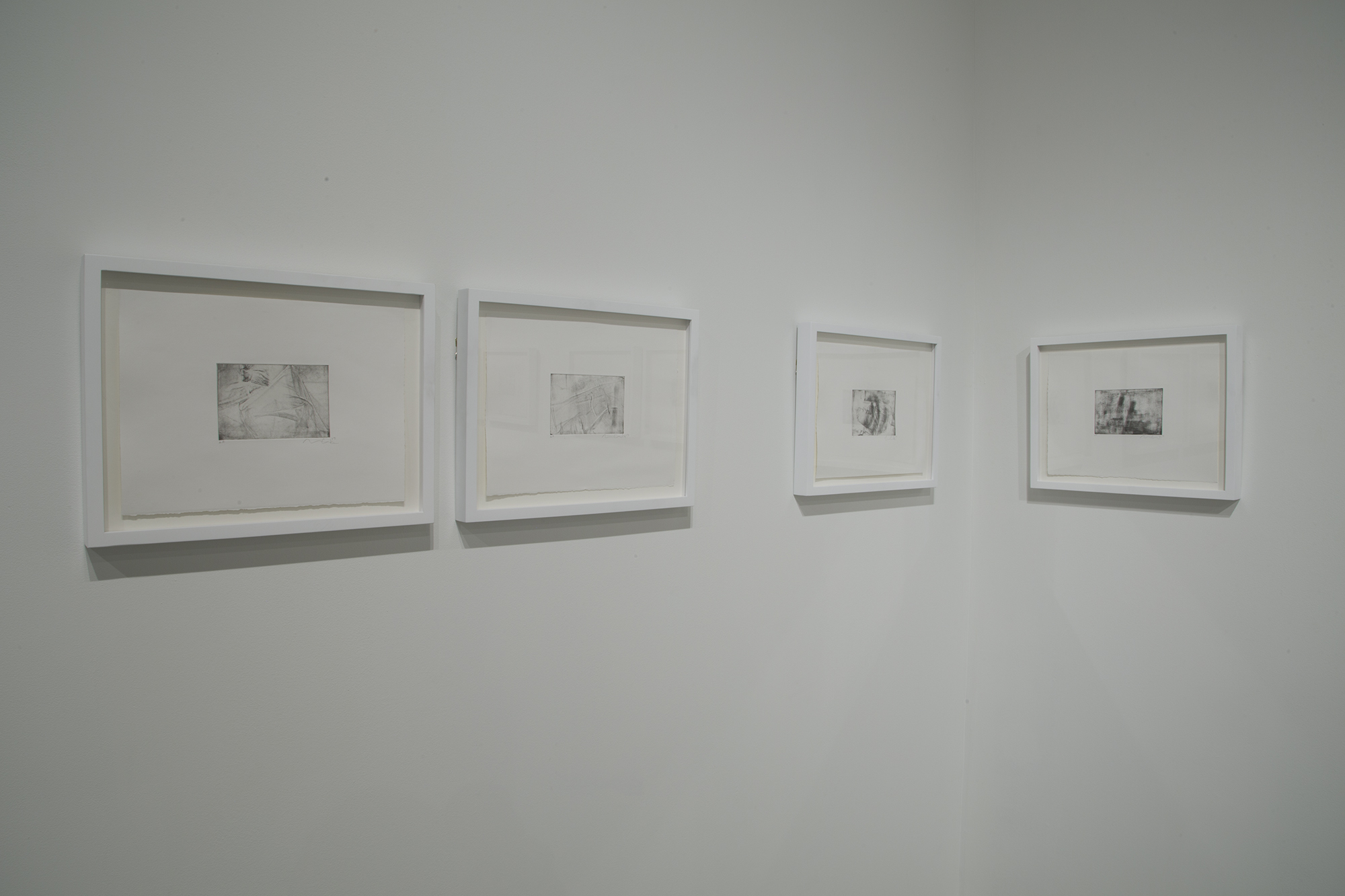
Installation view, 2017, Haw Contemporary, Kansas City, MO (photo by Brian Hawkins)

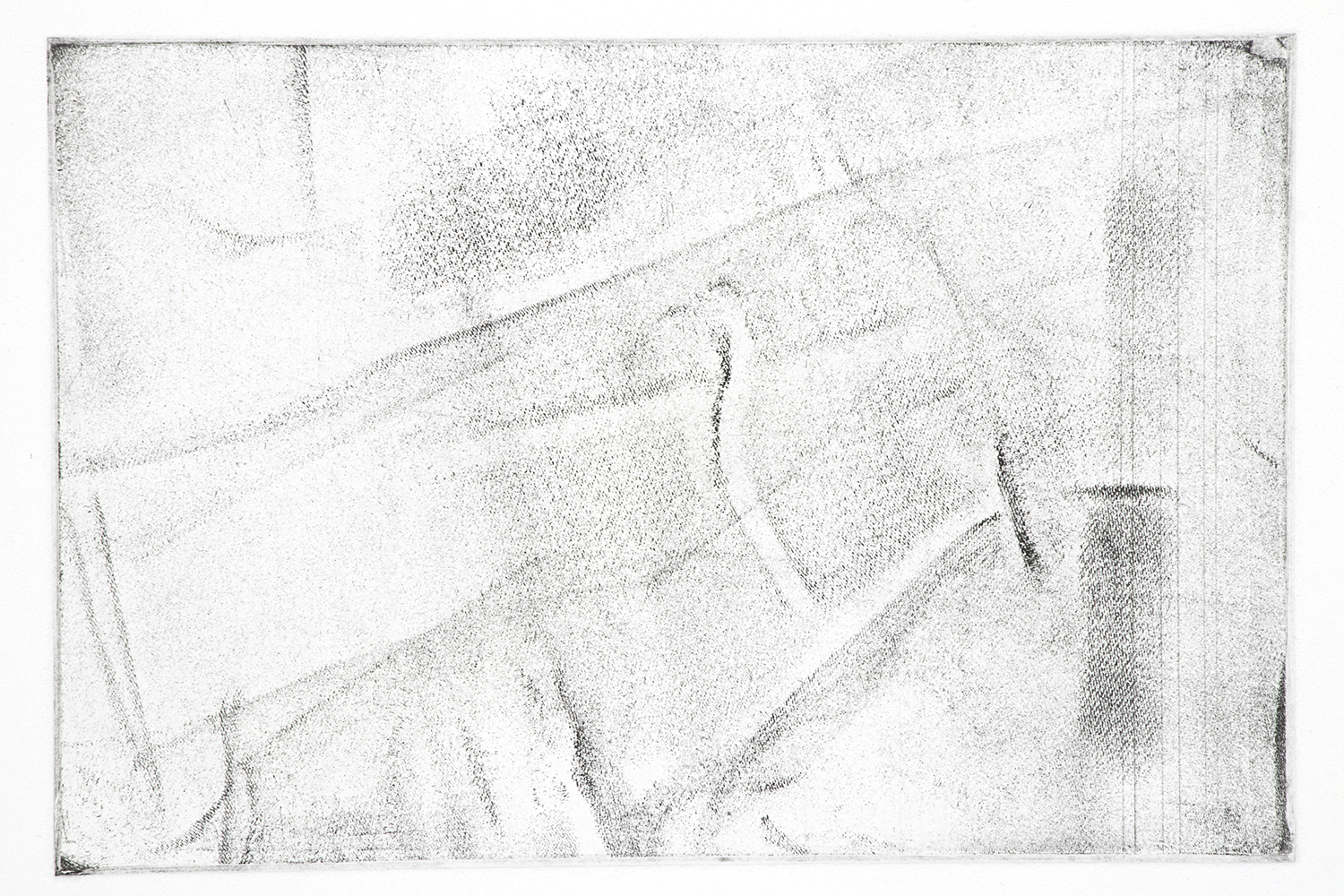










Pillow Talk is a portfolio of soft ground etchings named after a colloquial phrase suggesting intimate communication happening in bed, post-coital and naked in its honesty. Each print is a literal impression of both a gesture and a pillow case. Print’s visual language of reproducibility, multiplicity, and permanence is a foundation of my visual explorations. The works reflect my sentimentality towards physical connection over words within my relationships, particularly the way that a single touch can lovingly communicate ease, care, and yearning.
Can Dishwashing Be Queer?
2017For One, In A Shared Room is an exhibition of works on paper, sculpture, video, and installation visualizing the site and form of intimacy. The works collectively describe intimacy in context to the ordinary and how memory and feeling become embedded in the objects and spaces of home.
Preview of Can Dishwashing Be Queer?, 2017, HD video with sound, 25 minutes
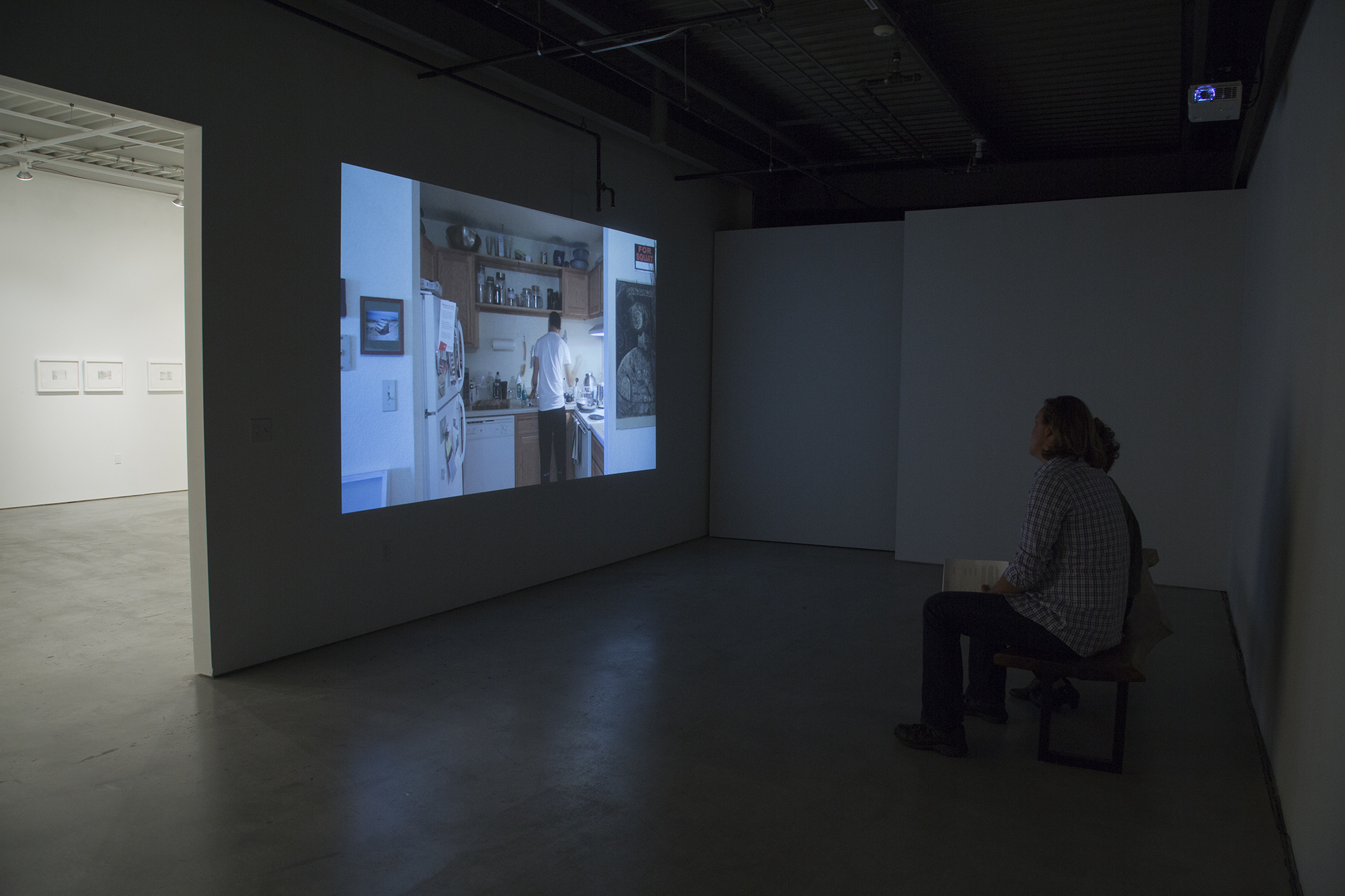
Installation View (photo by Brian Hawkins)



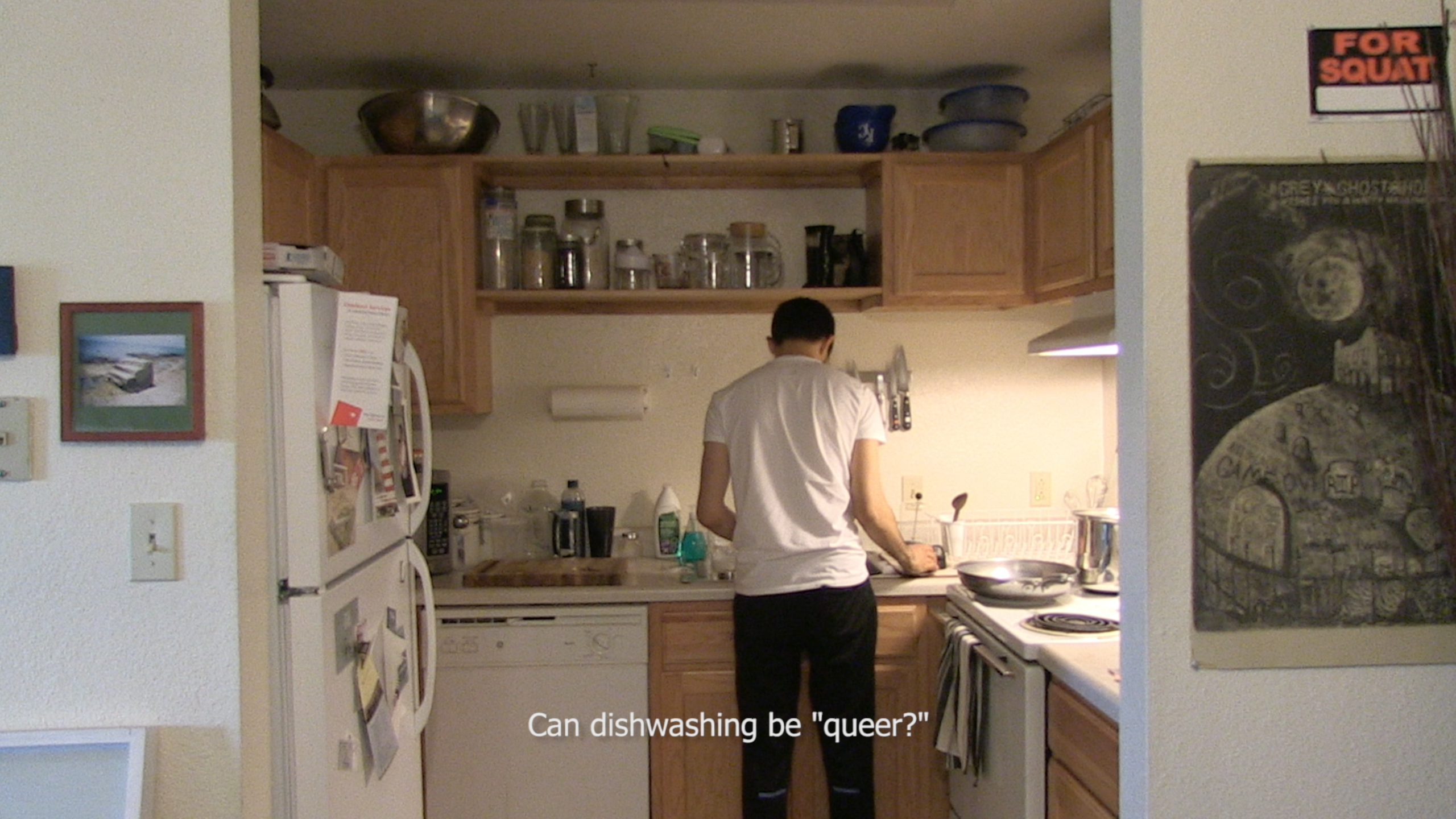
Still from Can Dishwashing Be Queer?, 2017, HD Video
Can Dishwashing Be Queer? is a 25 minute video documenting me washing dishes built up over the span of a week. The sounds from the video reverberate through the exhibition space, creating an aural ambiance transforming the gallery. The site of the performance continues with my fascination of corners in the home, the place where Gaston Bachelard writes in The Poetics of Space where daydreams occur. Throughout the tedious activity, my thoughts are subtitled in a stream-of-consciousness manner. I reflect on the process and labor involved in this activity, making a tongue-in-cheek reference to the Brown figure being “the dishwasher.” Various non-sequiturs, some of which break the fourth wall, illustrate our ability to drift off in our tasks and speculate. I reflect on the present moment and my intimate relationships in this performance, transforming the kitchen into a contemplative space to consider hopes and dreams for the future.
Drawing of Our Closet (Love Notes)
2017For One, In A Shared Room is an exhibition of works on paper, sculpture, video, and installation visualizing the site and form of intimacy. The works collectively describe intimacy in context to the ordinary and how memory and feeling become embedded in the objects and spaces of home.
Drawing of Our Closet
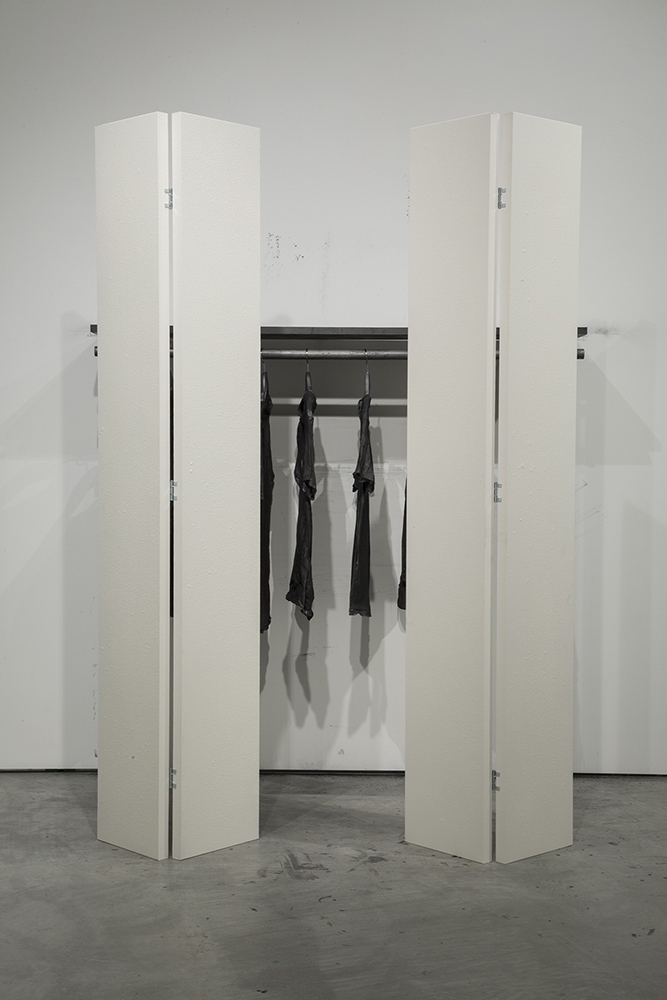
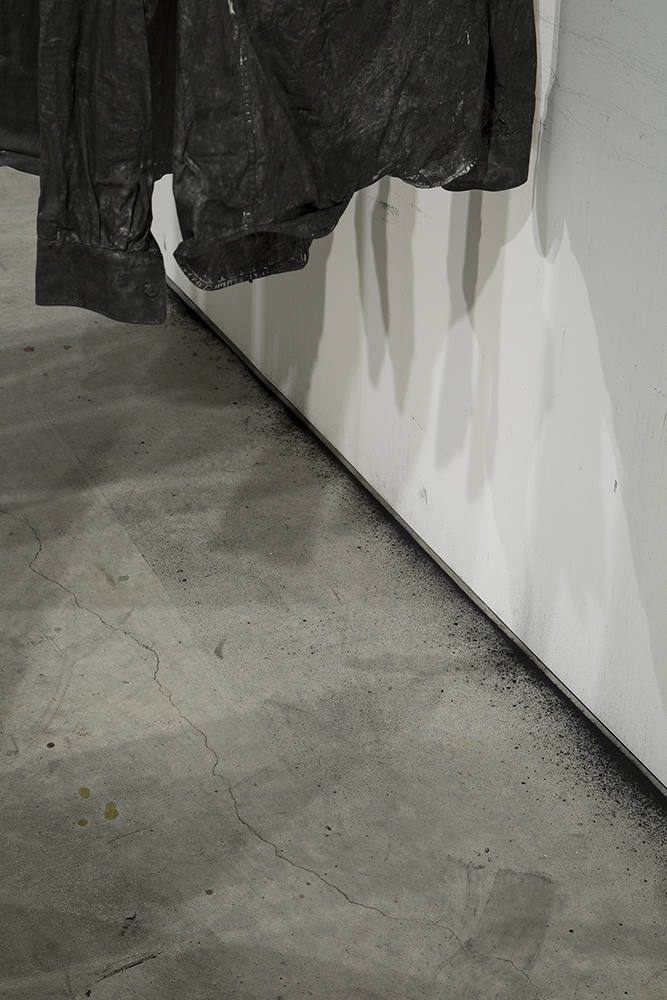
Drawing of Our Closet (Love Notes), 2017, two wooden bi-fold closet doors, wall spray texture, latex paint, fabric, wood, metal brackets, IKEA wooden hangers, enamel, graphite powder (photo by Brian Hawkins)

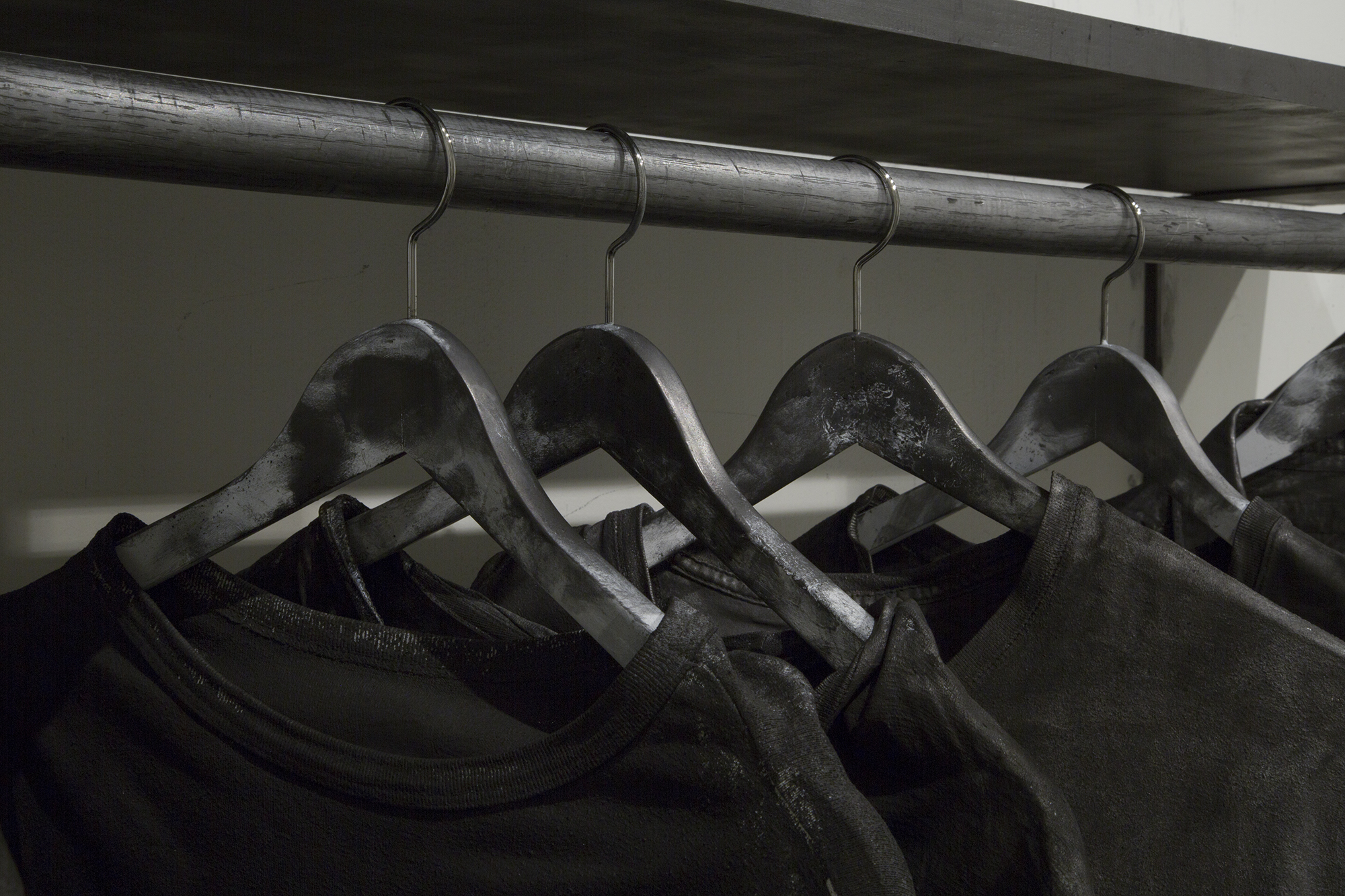





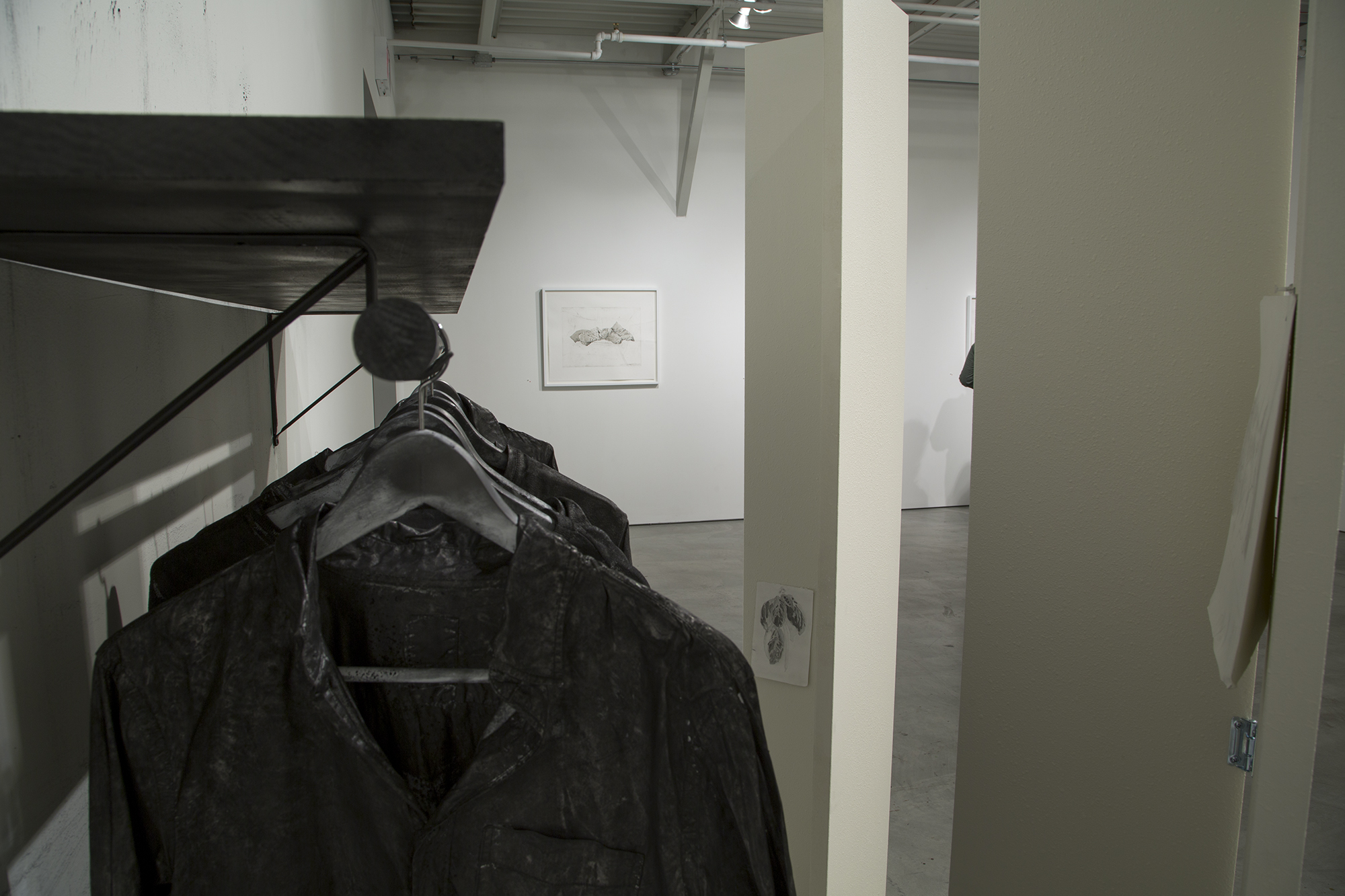
Drawing of Our Closet (Love Notes), 2017, two wooden bi-fold closet doors, wall spray texture, latex paint, fabric, wood, metal brackets, IKEA wooden hangers, enamel, graphite powder (photo by Brian Hawkins)
Drawing of Our Closet (Love Notes) is a mixed media installation of ready-made objects that have been treated in a variety of manners that queer the objects and the space they occupy. In its entirety, this work is about queerness’ root etymology in something being strange, weird, or off. In this case, the white cube gallery becomes off as these exposed pieces intended for apartment living become installed here, as do the materials themselves. Unfolding in three parts, the first part of installation consists of two wooden bi-fold closet doors treated with an orange-peel texture and painted “off-white”. This texture and color was a familiar affect for me, being the same found in my apartment.
These two hinged doors/walls, acting like two figures on guard, are half open to reveal the second part: the “inside” of the closet. Continuing to mimic the closet in my apartment, I use the same cheap materials available at traditional hardware stores like Home Depot. The clothes hanging on the rack are a combination of old shirts worn by my partner and me. Each object is primed with white paint and then buffed with graphite across every square inch of surface – my proposal of what a sculptural drawing might look like. The loose graphite stains the walls and floor of the gallery space as evidence of my mark on the space.
(Love Notes)

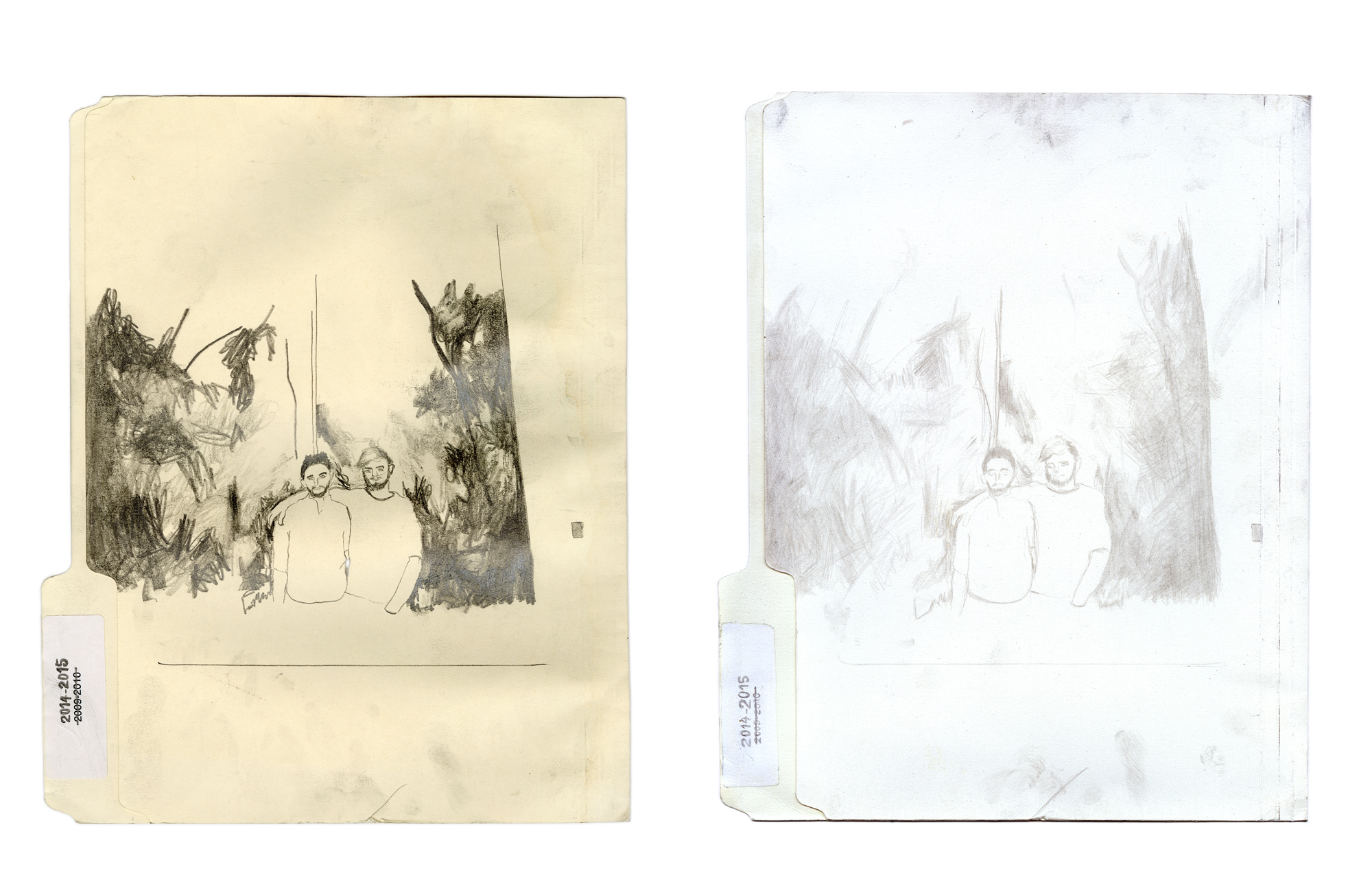
Inside each set of closet doors is a pair of drawings mirroring one another, the third and final part of this installation. Each door is installed at a right angle to form two corners. On the left side is an original drawing and on the right is a careful recreation of it. In his book The Poetics of Space, Gaston Bachelard breaks down the architecture of a house as metaphors for how we experience the world. The corners found in our homes were the sites where we daydream, according to Bachelard. Acting as a gesture of reciporicty to my partner, these drawings were our love notes that we passed back and forth to one another: a painting of our basil plant by me to them and a drawing of us by them to me. We both kept these drawings in specific places, pinned into walls or on shelves in personal spaces we would see every day. Both the height and the hanging apparatuses for these drawings are mimicked in this corner to honor the places we kept these gifts to one another. These drawings, to anyone who looks carefully and discovers them, both reveal a part of myself and become endearing statements on the nature of gifts and the couple.